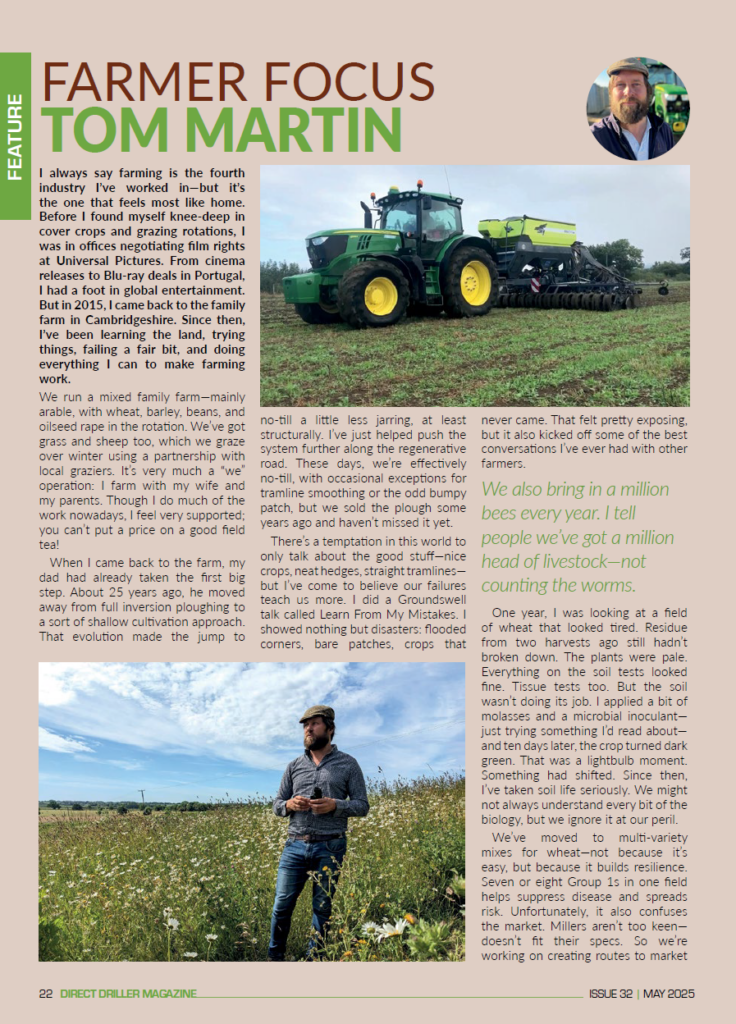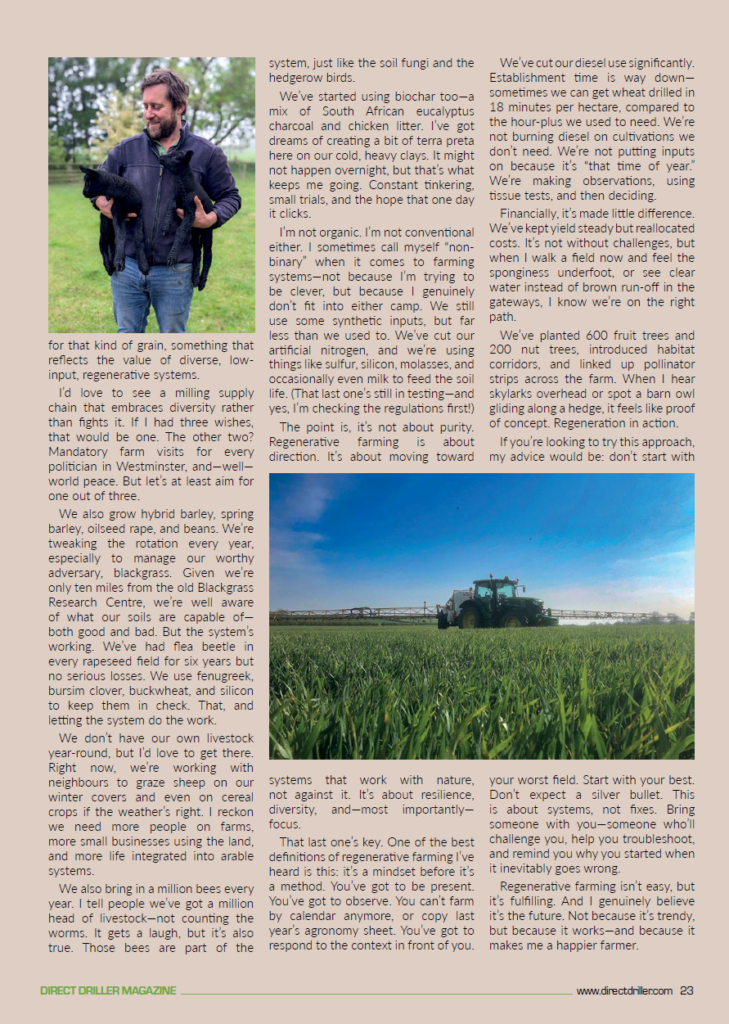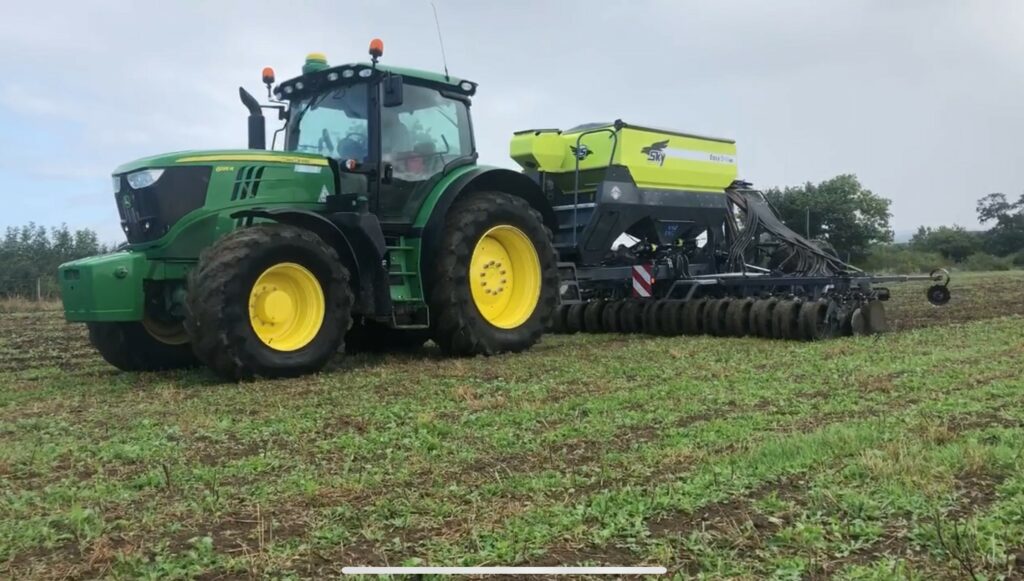April 2025
I always say farming is the fourth industry I’ve worked in—but it’s the one that feels most like home. Before I found myself knee-deep in cover crops and grazing rotations, I was in offices negotiating film rights at Universal Pictures. From cinema releases to Blu-ray deals in Portugal, I had a foot in global entertainment. But in 2015, I came back to the family farm in Cambridgeshire. Since then, I’ve been learning the land, trying things, failing a fair bit, and doing everything I can to make farming work.
We run a mixed family farm—mainly arable, with wheat, barley, beans, and oilseed rape in the rotation. We’ve got grass and sheep too, which we graze over winter using a partnership with local graziers. It’s very much a “we” operation: I farm with my wife and my parents. Though I do much of the work nowadays, I feel very supported; you can’t put a price on a good field tea!
When I came back to the farm, my dad had already taken the first big step. About 25 years ago, he moved away from full inversion ploughing to a sort of shallow cultivation approach. That evolution made the jump to no-till a little less jarring, at least structurally. I’ve just helped push the system further along the regenerative road. These days, we’re effectively no-till, with occasional exceptions for tramline smoothing or the odd bumpy patch, but we sold the plough some years ago and haven’t missed it yet.
There’s a temptation in this world to only talk about the good stuff—nice crops, neat hedges, straight tramlines—but I’ve come to believe our failures teach us more. I did a Groundswell talk called Learn From My Mistakes. I showed nothing but disasters: flooded corners, bare patches, crops that never came. That felt pretty exposing, but it also kicked off some of the best conversations I’ve ever had with other farmers.
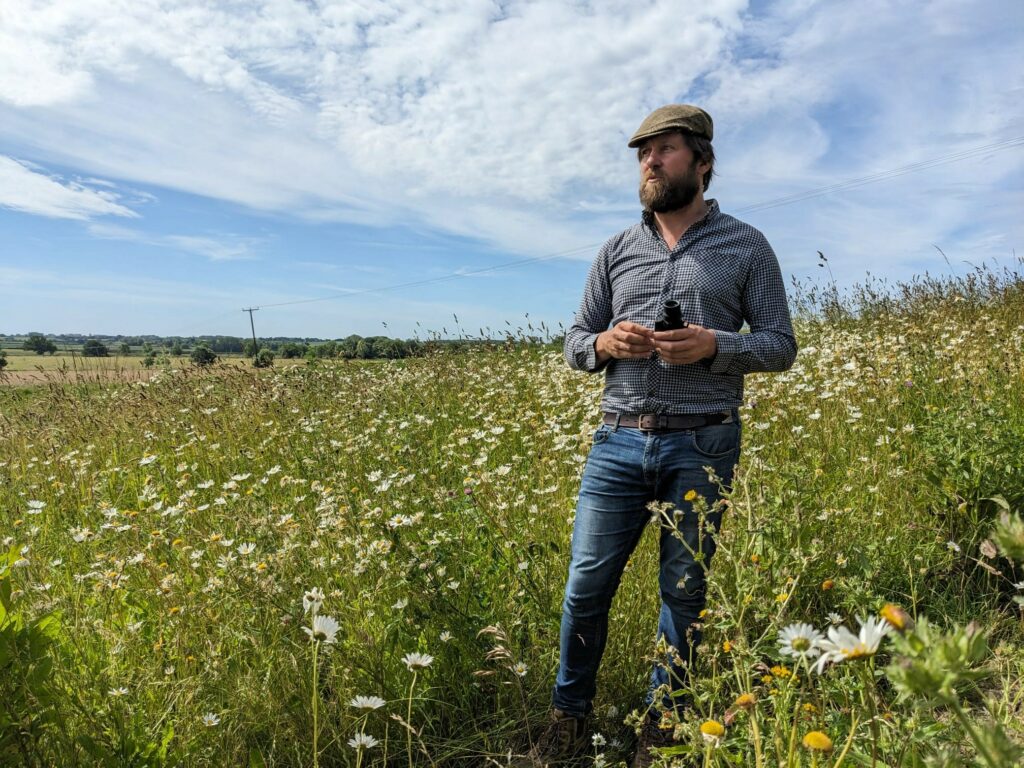
One year, I was looking at a field of wheat that looked tired. Residue from two harvests ago still hadn’t broken down. The plants were pale. Everything on the soil tests looked fine. Tissue tests too. But the soil wasn’t doing its job. I applied a bit of molasses and a microbial inoculant—just trying something I’d read about—and ten days later, the crop turned dark green. That was a lightbulb moment. Something had shifted. Since then, I’ve taken soil life seriously. We might not always understand every bit of the biology, but we ignore it at our peril.
We’ve moved to multi-variety mixes for wheat—not because it’s easy, but because it builds resilience. Seven or eight Group 1s in one field helps suppress disease and spreads risk. Unfortunately, it also confuses the market. Millers aren’t too keen—doesn’t fit their specs. So we’re working on creating routes to market for that kind of grain, something that reflects the value of diverse, low-input, regenerative systems.
I’d love to see a milling supply chain that embraces diversity rather than fights it. If I had three wishes, that would be one. The other two? Mandatory farm visits for every politician in Westminster, and—well—world peace. But let’s at least aim for one out of three.
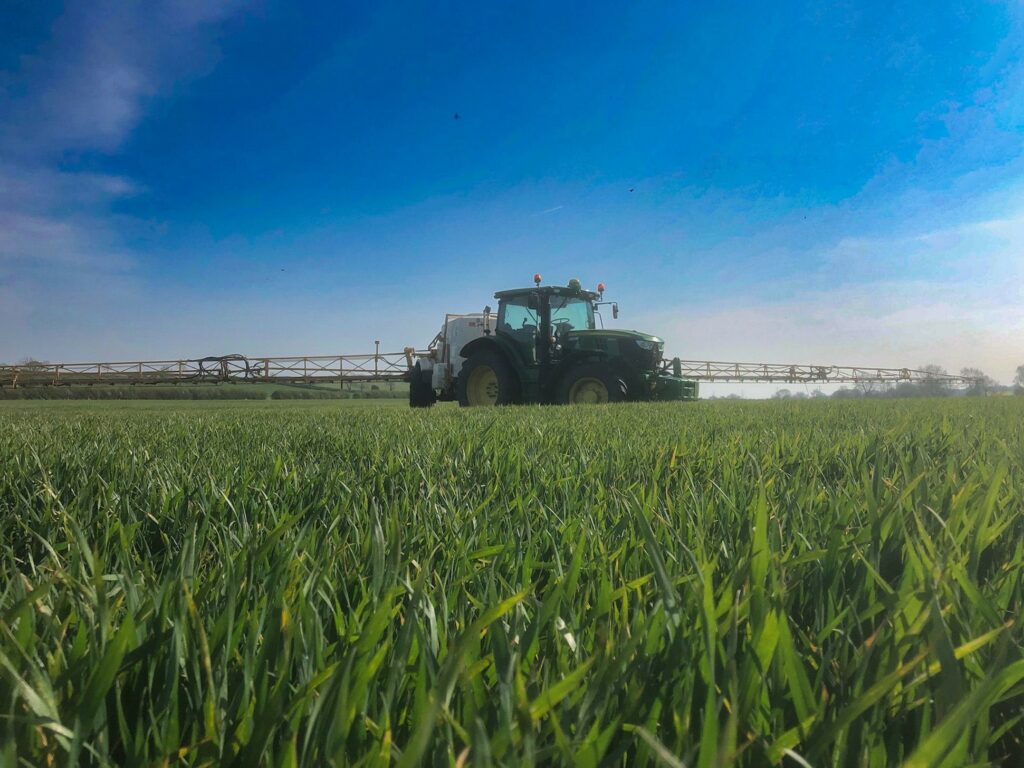
We also grow hybrid barley, spring barley, oilseed rape, and beans. We’re tweaking the rotation every year, especially to manage our worthy adversary, blackgrass. Given we’re only ten miles from the old Blackgrass Research Centre, we’re well aware of what our soils are capable of—both good and bad. But the system’s working. We’ve had flea beetle in every rapeseed field for six years but no serious losses. We use fenugreek, bursim clover, buckwheat, and silicon to keep them in check. That, and letting the system do the work.
We don’t have our own livestock year-round, but I’d love to get there. Right now, we’re working with neighbours to graze sheep on our winter covers and even on cereal crops if the weather’s right. I reckon we need more people on farms, more small businesses using the land, and more life integrated into arable systems.
We also bring in a million bees every year. I tell people we’ve got a million head of livestock—not counting the worms. It gets a laugh, but it’s also true. Those bees are part of the system, just like the soil fungi and the hedgerow birds.
We’ve started using biochar too—a mix of South African eucalyptus charcoal and chicken litter. I’ve got dreams of creating a bit of terra preta here on our cold, heavy clays. It might not happen overnight, but that’s what keeps me going. Constant tinkering, small trials, and the hope that one day it clicks.
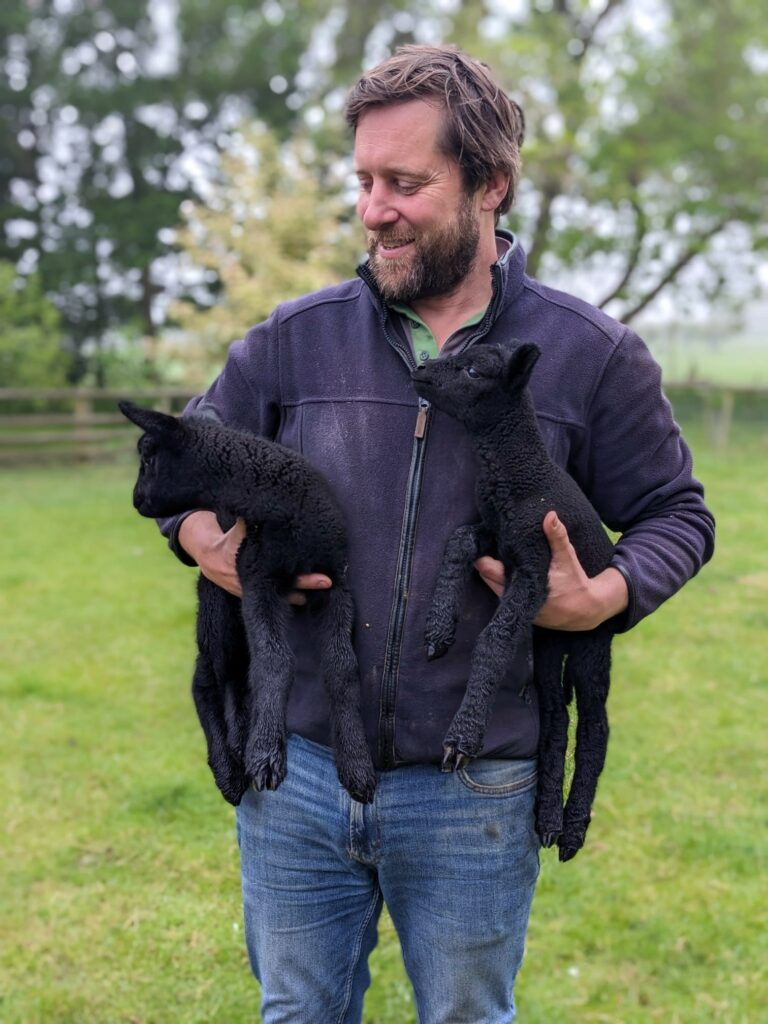
I’m not organic. I’m not conventional either. I sometimes call myself “non-binary” when it comes to farming systems—not because I’m trying to be clever, but because I genuinely don’t fit into either camp. We still use some synthetic inputs, but far less than we used to. We’ve cut our artificial nitrogen, and we’re using things like sulfur, silicon, molasses, and occasionally even milk to feed the soil life. (That last one’s still in testing—and yes, I’m checking the regulations first!)
The point is, it’s not about purity. Regenerative farming is about direction. It’s about moving toward systems that work with nature, not against it. It’s about resilience, diversity, and—most importantly—focus.
That last one’s key. One of the best definitions of regenerative farming I’ve heard is this: it’s a mindset before it’s a method. You’ve got to be present. You’ve got to observe. You can’t farm by calendar anymore, or copy last year’s agronomy sheet. You’ve got to respond to the context in front of you.
We’ve cut our diesel use significantly. Establishment time is way down—sometimes we can get wheat drilled in 18 minutes per hectare, compared to the hour-plus we used to need. We’re not burning diesel on cultivations we don’t need. We’re not putting inputs on because it’s “that time of year.” We’re making observations, using tissue tests, and then deciding.
Financially, it’s made little difference. We’ve kept yield steady but reallocated costs. It’s not without challenges, but when I walk a field now and feel the sponginess underfoot, or see clear water instead of brown run-off in the gateways, I know we’re on the right path.
We’ve planted 600 fruit trees and 200 nut trees, introduced habitat corridors, and linked up pollinator strips across the farm. When I hear skylarks overhead or spot a barn owl gliding along a hedge, it feels like proof of concept. Regeneration in action.
If you’re looking to try this approach, my advice would be: don’t start with your worst field. Start with your best. Don’t expect a silver bullet. This is about systems, not fixes. Bring someone with you—someone who’ll challenge you, help you troubleshoot, and remind you why you started when it inevitably goes wrong.
Regenerative farming isn’t easy, but it’s fulfilling. And I genuinely believe it’s the future. Not because it’s trendy, but because it works—and because it makes me a happier farmer.
